Sailing ship
A sailing ship is a sea-going vessel that uses sails mounted on masts to harness the power of wind and propel the vessel. There is a variety of sail plans that propel sailing ships, employing square-rigged or fore-and-aft sails. Some ships carry square sails on each mast—the brig and full-rigged ship, said to be "ship-rigged" when there are three or more masts.[1] Others carry only fore-and-aft sails on each mast—schooners. Still others employ a combination of square and fore-and aft sails, including the barque, barquentine, and brigantine.[2] Sailing ships developed differently in Asia, which produced the junk and dhow—vessels that incorporated innovations absent in European ships of the time. Technically in the Age of Sail a ship was a specific type of vessel, with a bowsprit and three masts, each of which consists of a lower, top, and topgallant mast.[3]
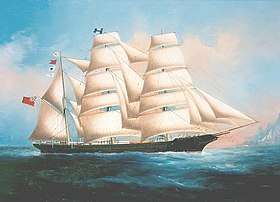
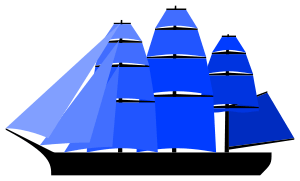
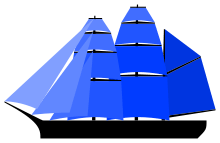
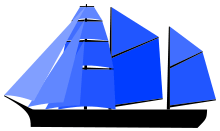

Sailing ships with predominantly square rigs became prevalent during the Age of Discovery, when they crossed oceans between continents and around the world. Most sailing ships were merchantmen, but the Age of Sail also saw the development of large fleets of well-armed warships. The Age of Sail waned with the advent of steam-powered ships, which did not depend upon a favourable wind.
History
The first sailing vessels were developed for use in the South China Sea and also independently in lands abutting the western Mediterranean Sea by the 2nd millennium BCE. In Asia, early vessels were equipped with crab claw sails—with a spar on the top and bottom of the sail, arranged fore-and-aft when needed. In the Mediterranean, vessels were powered downwind by square sails that supplemented propulsion by oars. Sailing ships evolved differently in the South China Sea and in the Indian Ocean, where fore-and-aft sail plans were developed several centuries into the Common Era. By the time of the Age of Discovery—starting in the 15th century—square-rigged, multi-masted vessels were the norm and were guided by navigation techniques that included the magnetic compass and making sightings of the sun and stars that allowed transoceanic voyages. The Age of Sail reached its peak in the 18th and 19th centuries with large, heavily armed battleships and merchant sailing ships that were able to travel at speeds that exceeded those of the newly introduced steamships. Ultimately, the steamships' independence from the wind and their ability to take shorter routes, passing through the Suez and Panama Canals,[4] made sailing ships uneconomical.
Before 1700
Initially sails provided supplementary power to ships with oars, because the sails were not designed to sail to windward. In Asia sailing ships were equipped with fore-and-aft rigs that made sailing to windward possible. Later square-rigged vessels too were able to sail to windward, and became the standard for European ships through the Age of Discovery when vessels ventured around Africa to India, to the Americas and around the world. Later during this period—in the late 15th century—"ship-rigged" vessels with multiple square sails on each mast appeared and became common for sailing ships.[5]
Mediterranean and Baltic
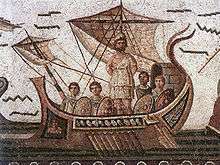
Sailing ships in the Mediterranean region date to 3000 BCE, when Egyptians used a bipod mast to support a single square sail on a vessel that mainly relied on multiple paddlers. Later the mast became a single pole, and paddles were supplanted with oars. Such vessels plied both the Nile and the Mediterranean coast. The inhabitants of Crete had sailing vessels by 1200 BCE. Between 1000 BCE and 400 CE, the Phoenicians, Greeks and Romans developed ships that were powered by square sails, sometimes with oars to supplement their capabilities. Such vessels used a steering oar as a rudder to control direction. Fore-and-aft sails started appearing on sailing vessels in the Mediterranean ca.1200 CE,[5] an influence of rigs introduced in Asia and the Indian Ocean.[6]
Starting in the 8th century in Denmark, Vikings were building clinker-constructed longships propelled by a single, square sail, when practical, and oars, when necessary.[7] A related craft was the knarr, which plied the Baltic and North Seas, using primarily sail power.[8] The windward edge of the sail was stiffened with a beitass, a pole that fitted into the lower corner of the sail, when sailing close to the wind.[9]
South China Sea
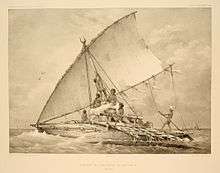
The first sea-going sailing ships in Asia were developed by the Austronesian peoples from what is now Southern China and Taiwan. Their invention of catamarans, outriggers, and crab claw sails enabled the Austronesian Expansion at around 3000 to 1500 BCE. From Taiwan, they rapidly colonized the islands of Maritime Southeast Asia, then sailed further onwards to Micronesia, Island Melanesia, Polynesia, and Madagascar. Austronesian rigs were distinctive in that they had spars supporting both the upper and lower edges of the sails (and sometimes in between), in contrast to western rigs which only had a spar on the upper edge.[10][11][12]
Early Austronesian sailors also influenced the development of sailing technologies in Sri Lanka and Southern India through the Austronesian maritime trade network of the Indian Ocean, the precursor to the spice trade route and the maritime silk road.[13] Austronesians established the first maritime trade network with ocean-going merchant ships which plied the early trade routes from Southeast Asia from at least 1500 BCE. They reached as far northeast as Japan and as far west as eastern Africa. They colonized Madagascar and their trade routes were the precursors to the spice trade route and the maritime silk road. They mainly facilitated trade of goods from China and Japan to South India, Sri Lanka, the Persian Gulf, and the Red Sea.[13]][14][15] An important invention in this region was the fore-and-aft rig, which made sailing against the wind possible. Such sails may have originated at least several hundred years BCE.[16] Balance lugsails and tanja sails also originated from this region. Vessels with such sails explored and traded along the western coast of Africa. This type of sail propagated to the west and influenced Arab lateen designs.[16]
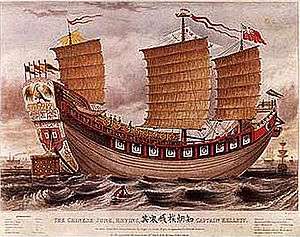
Large Austronesian trading ships with as many as four sails were recorded by Han Dynasty (206 BCE – 220 CE) scholars as the kunlun bo (崑崙舶, lit. "ship of the Kunlun people"). They were booked by Chinese Buddhist pilgrims for passage to Southern India and Sri Lanka.[17] Bas reliefs of Sailendran and Srivijayan large merchant ships with various configurations of tanja sails and outriggers are also found in the Borobudur temple, dating back to the 8th century CE.[18][19]
By the 10th century CE, the Song Dynasty started building the first Chinese junks, which were adopted from the design of the Javanese djongs. The junk rig in particular, became associated with Chinese coast-hugging trading ships.[20][21] Junks in China were constructed from teak with pegs and nails; they featured watertight compartments and acquired center-mounted tillers and rudders.[22] These ships became the basis for the development of Chinese warships during the Mongol Yuan Dynasty, and were used in the unsuccessful Mongol invasions of Japan and Java.[23][24]
The Ming dynasty (1368–1644) saw the use of junks as long-distance trading vessels. Chinese Admiral Zheng He reportedly sailed to India, Arabia, and southern Africa on a trade and diplomatic mission.[25][26] Literary lore suggests that his largest vessel, the "Treasure Ship", measured 400 feet (120 m) in length and 150 feet (46 m) in width, whereas modern research suggests that it was unlikely to have exceeded 200 feet (61 m) in length.[27]
Indian Ocean
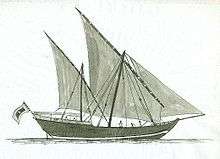
The Indian Ocean was the venue for increasing trade between India and Africa between 1200 and 1500. The vessels employed would be classified as dhows with lateen rigs. During this interval such vessels grew in capacity from 100 to 400 tonnes. Dhows were often built with teak planks from India and Southeast Asia, sewn together with coconut husk fiber—no nails were employed. This period also saw the implementation of center-mounted rudders, controlled with a tiller.[28]
Global exploration
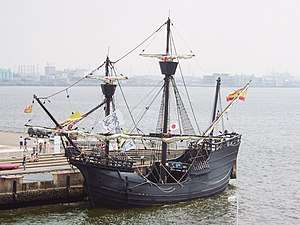
Technological advancements that were important to the Age of Discovery in the 15th century were the adoption of the magnetic compass and advances in ship design.
The compass was an addition to the ancient method of navigation based on sightings of the sun and stars. The compass was invented by Chinese. It had been used for navigation in China by the 11th century and was adopted by the Arab traders in the Indian Ocean. The compass spread to Europe by the late 12th or early 13th century.[6] Use of the compass for navigation in the Indian Ocean was first mentioned in 1232.[20] The Europeans used a "dry" compass, with a needle on a pivot. The compass card was also a European invention.[20]
At the beginning of the 15th century, the carrack was the most capable European ocean-going ship. It was carvel-built and large enough to be stable in heavy seas. It was capable of carrying a large cargo and the provisions needed for very long voyages. Later carracks were square-rigged on the foremast and mainmast and lateen-rigged on the mizzenmast. They had a high rounded stern with large aftcastle, forecastle and bowsprit at the stem. As the predecessor of the galleon, the carrack was one of the most influential ship designs in history; while ships became more specialized in the following centuries, the basic design remained unchanged throughout this period.[29]
Ships of this era were only able to sail approximately 70° into the wind and tacked from one side to the other across the wind with difficulty, which made it challenging to avoid shipwrecks when near shores or shoals during storms.[30] Nonetheless, such vessels reached India around Africa with Vasco da Gama,[31] the Americas with Christopher Columbus,[32] and around the world under Ferdinand Magellan.[33]
1700 to 1850
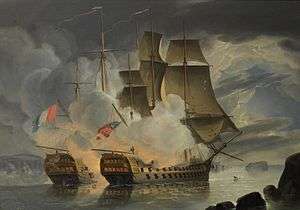
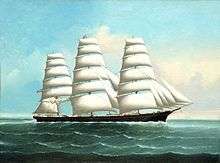
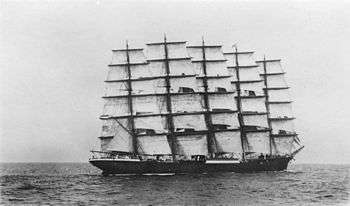
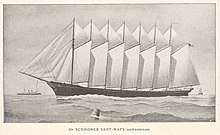
Sailing ships became longer and faster over time, with ship-rigged vessels carrying taller masts with more square sails. Other sail plans emerged, as well, that had just fore-and-aft sails (schooners), or a mixture of the two (brigantines, barques and barquentines).[5]
Warships
Cannon were present in the 14th century, but did not become common at sea until they could be reloaded quickly enough to be reused in the same battle. The size of a ship required to carry a large number of cannon made oar-based propulsion impossible, and warships came to rely primarily on sails. The sailing man-of-war emerged during the 16th century.[34]
By the middle of the 17th century, warships were carrying increasing numbers of cannon on three decks. Naval tactics evolved to bring each ship's firepower to bear in a line of battle—coordinated movements of a fleet of warships to engage a line of ships in the enemy fleet.[35] Carracks with a single cannon deck evolved into galleons with as many as two full cannon decks,[36] which evolved into the man-of-war, and further into the ship of the line—designed for engaging the enemy in a line of battle. One side of a ship was expected to shoot broadsides against an enemy ship at close range.[35] In the 18th century, the small and fast frigate and sloop-of-war—too small to stand in the line of battle—evolved to convoy trade, scout for enemy ships and blockade enemy coasts.[37]
Clippers
Fast schooners and brigantines, called Baltimore clippers, were used for blockade running and as privateers in the early 1800s. These evolved into three-masted, usually ship-rigged sailing vessels, optimized for speed with fine lines that lessened their cargo capacity.[38] Sea trade with China became important in that period which favored a combination of speed and cargo volume, which was met by building vessels with long waterlines, fine bows and tall masts, generously equipped with sails for maximum speed. Masts were as high as 100 feet (30 m) and were able to achieve speeds of 19 knots (35 km/h), allowing for passages of up to 465 nautical miles (861 km) per 24 hours. Clippers yielded to bulkier, slower vessels, which became economically competitive in the mid 19th century.[39]
Copper sheathing
During the Age of Sail, ships' hulls were under frequent attack by shipworm (which affected the structural strength of timbers), and barnacles and various marine weeds (which affected ship speed).[40] Since before the common era, a variety of coatings had been applied to hulls to counter this effect, including pitch, wax, tar, oil, sulfur and arsenic.[41] In the mid 18th century copper sheathing was developed as a defense against such bottom fouling.[42] After coping with problems of galvanic deterioration of metal hull fasteners, sacrificial anodes were developed, which were designed to corrode, instead of the hull fasteners.[43] The practice became widespread on naval vessels, starting in the late18th century,[44] and on merchant vessels, starting in the early 19th century, until the advent of iron and steel hulls.[43]
After 1850
Iron-hulled sailing ships, often referred to as "windjammers" or "tall ships",[45] represented the final evolution of sailing ships at the end of the Age of Sail. They were built to carry bulk cargo for long distances in the nineteenth and early twentieth centuries. They were the largest of merchant sailing ships, with three to five masts and square sails, as well as other sail plans. They carried lumber, guano, grain or ore between continents. Later examples had steel hulls. Iron-hulled sailing ships were mainly built from the 1870s to 1900, when steamships began to outpace them economically, due to their ability to keep a schedule regardless of the wind. Steel hulls also replaced iron hulls at around the same time. Even into the twentieth century, sailing ships could hold their own on transoceanic voyages such as Australia to Europe, since they did not require bunkerage for coal nor fresh water for steam, and they were faster than the early steamers, which usually could barely make 8 knots (15 km/h).[46]
The four-masted, iron-hulled ship, introduced in 1875 with the full-rigged County of Peebles, represented an especially efficient configuration that prolonged the competitiveness of sail against steam in the later part of the 19th century.[47] The largest example of such ships was the five-masted, full-rigged ship Preussen, which had a load capacity of 7,800 tonnes.[48] Ships transitioned from all sail to all steam-power during from the mid 19th century into the 20th.[49] Five-masted Preussen used steam power for driving the winches, hoists and pumps, and could be manned by a crew of 48, compared with four-masted Kruzenshtern, which has a crew of 257.[50]
Coastal top-sail schooners with a crew as small as two managing the sail handling became an efficient way to carry bulk cargo, since only the fore-sails required tending while tacking and steam-driven machinery was often available for raising the sails and the anchor.[51]
In the 20th century, the DynaRig allowed central, automated control of all sails in a manner that obviates the need for sending crew aloft. This was developed in the 1960s in Germany as a low-carbon footprint propulsion alternative for commercial ships. The rig automatically sets and reefs sails; its mast rotates to align the sails with the wind. The sailing yachts Maltese Falcon and Black Pearl employ the rig.[50][52]
Features
Every sailing ship has a sail plan that is adapted to the purpose of the vessel and the ability of the crew; each has a hull, rigging and masts to hold up the sails that use the wind to power the ship; the masts are supported by standing rigging and the sails are adjusted by running rigging.
Hull
%2C_body_plan.jpg)
Hull shapes for sailing ships evolved from being relatively short and blunt to being longer and finer at the bow.[5] By the nineteenth century, ships were built with reference to a half model, made from wooden layers that were pinned together. Each layer could be scaled to the actual size of the vessel in order to lay out its hull structure, starting with the keel and leading to the ship's ribs. The ribs were pieced together from curved elements, called futtocks and tied in place until the installation of the planking. Typically, planking was caulked with a tar-impregnated yarn made from manila or hemp to make the planking watertight.[53] Starting in the mid-19th century, iron was used first for the hull structure and later for its watertight sheathing.[54]
Masts
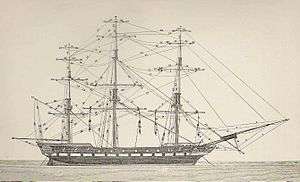
Until the mid-19th century all vessels' masts were made of wood formed from a single or several pieces of timber which typically consisted of the trunk of a conifer tree. From the 16th century, vessels were often built of a size requiring masts taller and thicker than could be made from single tree trunks. On these larger vessels, to achieve the required height, the masts were built from up to four sections (also called masts), known in order of rising height above the decks as the lower, top, topgallant and royal masts.[56] Giving the lower sections sufficient thickness necessitated building them up from separate pieces of wood. Such a section was known as a made mast, as opposed to sections formed from single pieces of timber, which were known as pole masts.[57] Starting in the second half of the 19th century, masts were made of iron or steel.[5]
For ships with square sails the principal masts, given their standard names in bow to stern (front to back) order, are:
- Fore-mast – the mast nearest the bow, or the mast forward of the main-mast with sections: fore-mast lower, fore topmast, and fore topgallant mast[56]
- Main-mast – the tallest mast, usually located near the center of the ship with sections: main-mast lower, main topmast, main topgallant mast, royal mast (sometimes)[56]
- Mizzen-mast – the aft-most mast. Typically shorter than the fore-mast with sections: mizzen-mast lower, mizzen topmast, and mizzen topgallant mast.[58]
Sails
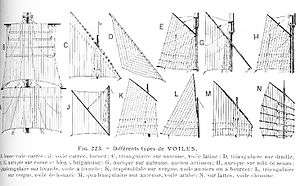
Each rig is configured in a sail plan, appropriate to the size of the sailing craft. Both square-rigged and fore-and-aft rigged vessels have been built with a wide range of configurations for single and multiple masts.[60]
Types of sail that can be part of a sail plan can be broadly classed by how they are attached to the sailing craft:
- To a stay – Sails attached to stays, include jibs, which are attached to forestays and staysails, which are mounted on other stays (typically wire cable) that support other masts from the bow aft.
- To a mast – Fore-and-aft sails directly attached to the mast at the luff include gaff-rigged quadrilateral and Bermuda triangular sails.
- To a spar – Sails attached to a spar include both square sails and such fore-and-aft quadrilateral sails as lug rigs, junk and spritsails and such triangular sails as the lateen, and the crab claw.
Rigging
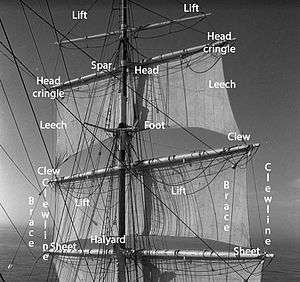
Sailing ships have standing rigging to support the masts and running rigging to raise the sails and control their ability to draw power from the wind. The running rigging has three main roles, to support the sail structure, to shape the sail and to adjust its angle to the wind. Square-rigged vessels require more controlling lines than fore-and-aft rigged ones.
Standing rigging
Sailing ships prior to the mid-19th century used wood masts with hemp-fiber standing rigging. As rigs became taller by the end of the 19th Century, masts relied more heavily on successive spars, stepped one atop the other to form the whole, from bottom to top: the lower mast, top mast, and topgallant mast. This construction relied heavily on support by a complex array of stays and shrouds. Each stay in either the fore-and-aft or athwartships direction had a corresponding one in the opposite direction providing counter-tension. Fore-and-aft the system of tensioning started with the stays that were anchored in front each mast. Shrouds were tensioned by pairs deadeyes, circular blocks that had the large-diameter line run around them, whilst multiple holes allowed smaller line—lanyard—to pass multiple times between the two and thereby allow tensioning of the shroud. After the mid-19th century square-rigged vessels were equipped with steel-cable standing rigging.[61]
Running rigging
Halyards, used to raise and lower the yards, are the primary supporting lines.[62] In addition, square rigs have lines that lift the sail or the yard from which it is suspended that include: brails, buntlines, lifts and leechlines. Bowlines and clew lines shape a square sail.[55] To adjust the angle of the sail to wind braces are used to adjust the fore and aft angle of a yard of a square sail, while sheets attach to the clews (bottom corners) of a sail to control the sail's angle to the wind. Sheets run aft, whereas tacks are used to haul the clew of a square sail forward.[55]
Crew
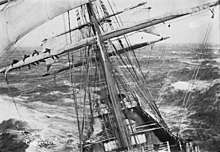
The crew of a sailing ship is divided between officers (the captain and his subordinates) and seamen or ordinary hands. An able seaman was expected to "hand, reef, and steer" (handle the lines and other equipment, reef the sails, and steer the vessel).[63] The crew is organized to stand watch—the oversight of the ship for a period—typically four hours each.[64] Richard Henry Dana Jr. and Herman Melville each had personal experience aboard sailing vessels of the 19th century.
Merchant vessel
Dana described the crew of the merchant brig, Pilgrim, as comprising six to eight common sailors, four specialist crew members (the steward, cook, carpenter and sailmaker), and three officers: the captain, the first mate and the second mate. He contrasted the American crew complement with that of other nations on whose similarly sized ships the crew might number as many as 30.[65] Larger merchant vessels had larger crews.[66]
Warship
Melville described the crew complement of the frigate warship, United States, as about 500—including officers, enlisted personnel and 50 Marines. The crew was divided into the starboard and larboard watches. It was also divided into three tops, bands of crew responsible for setting sails on the three masts; a band of sheet-anchor men, whose station was forward and whose job was to tend the fore-yard, anchors and forward sails; the after guard, who were stationed aft and tended the mainsail, spanker and man the various sheets, controlling the position of the sails; the waisters, who were stationed midships and had menial duties attending the livestock, etc.; and the holders, who occupied the lower decks of the vessel and were responsible for the inner workings of the ship. He additionally named such positions as, boatswains, gunners, carpenters, coopers, painters, tinkers, stewards, cooks and various boys as functions on the man-of-war.[67] 18-19th century ships of the line had a complement as high as 850.[68]
Ship handling
_-_SLV_H99.220-2856.jpg)
Handling a sailing ship requires management of its sails to power—but not overpower—the ship and navigation to guide the ship, both at sea and in and out of harbors.
Under sail
Key elements of sailing a ship are setting the right amount of sail to generate maximum power without endangering the ship, adjusting the sails to the wind direction on the course sailed, and changing tack to bring the wind from one side of the vessel to the other.
Setting sail
A sailing ship crew manages the running rigging of each square sail. Each sail has two sheets that control its lower corners, two braces that control the angle of the yard, two clewlines, four buntlines and two reef tackles. All these lines must be manned as the sail is deployed and the yard raised. They use a halyard to raise each yard and its sail; then they pull or ease the braces to set the angle of the yard across the vessel; they pull on sheets to haul lower corners of the sail, clews, out to yard below. Under way, the crew manages reef tackles, haul leeches, reef points, to manage the size and angle of the sail; bowlines pull the leading edge of the sail (leech) taut when close hauled. When furling the sail, the crew uses clewlines, haul up the clews and buntlines to haul up the middle of sail up; when lowered, lifts support each yard.[69]
In strong winds, the crew is directed to reduce the number of sails or, alternatively, the amount of each given sail that is presented to the wind by a process called reefing. To pull the sail up, seamen on the yardarm pull on reef tackles, attached to reef cringles, to pull the sail up and secure it with lines, called reef points.[70] Dana spoke of the hardships of sail handling during high wind and rain or with ice covering the ship and its rigging.[65]
Changing tack
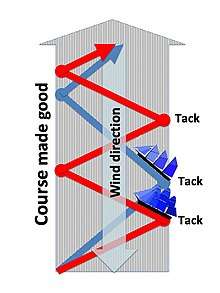
Sailing vessels cannot sail directly into the wind. Instead, square-riggers must sail a course that is between 60° and 70° away from the wind direction[71] and fore-and aft vessels can typically sail no closer than 45°.[72] To reach a destination, sailing vessels may have to change course and allow the wind to come from the opposite side in a procedure, called tacking, when the wind comes across the bow during the maneuver.
When tacking, a square-rigged vessel's sails must be presented squarely to the wind and thus impede forward motion as they are swung around via the yardarms through the wind as controlled by the vessel's running rigging, using braces—adjusting the fore and aft angle of each yardarm around the mast—and sheets attached to the clews (bottom corners) of each sail to control the sail's angle to the wind.[55] The procedure is to turn the vessel into the wind with the hind-most fore-and-aft sail (the spanker), pulled to windward to help turn the ship through the eye of the wind. Once the ship has come about, all the sails are adjusted to align properly with the new tack. Because square-rigger masts are more strongly braced from behind than from ahead, tacking is a dangerous procedure in strong winds; the ship may lose forward momentum (become caught in stays) and the rigging may fail from the wind coming from ahead. The ship may also lose momentum at wind speeds of less than 10 knots (19 km/h).[71] Under these conditions, the choice may be to wear ship—to turn the ship away from the wind and around 240° onto the next tack (60° off the wind).[73][74]
A fore-and-aft rig permits the wind to flow past the sail, as the craft head through the eye of the wind. Most rigs pivot around a stay or the mast, while this occurs. For a jib, the old leeward sheet is released as the craft heads through the wind and the old windward sheet is tightened as the new leeward sheet to allow the sail to draw wind. Mainsails are often self-tending and slide on a traveler to the opposite side.[75] On certain rigs, such as lateens[76] and luggers,[77] the sail may be partially lowered to bring it to the opposite side.
Navigation
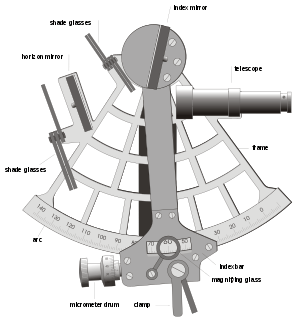
Early navigational techniques employed observations of the sun, stars, waves and birdlife. In the 15th century, the Chinese were using the magnetic compass to identify direction of travel. By the 16th century in Europe, navigational instruments included the quadrant, the astrolabe, cross staff, dividers and compass. By the time of the Age of Exploration these tools were being used in combination with a log to measure speed, a lead line to measure soundings, and a lookout to identify potential hazards. Later, an accurate marine sextant became standard for determining latitude and an accurate chronometer became standard for determining longitude.[78][79]
Passage planning begins with laying out a route along a chart, which comprises a series of courses between fixes—verifiable locations that confirm the actual track of the ship on the ocean. Once a course has been set, the person at the helm attempts to follow its direction with reference to the compass. The navigator notes the time and speed at each fix to estimate the arrival at the next fix, a process called dead reckoning. For coast-wise navigation, sightings from known landmarks or navigational aids may be used to establish fixes, a process called pilotage.[1] At sea, sailing ships used celestial navigation on a daily schedule, as follows:[80]
- Continuous dead reckoning plot
- Star observations at morning twilight for a celestial fix
- Morning sun observation to determine compass error by azimuth observation of the sun
- Noontime observation of the sun for noon latitude line for determination the day's run and day's set and drift
- Afternoon sun line to determine compass error by azimuth observation of the sun
- Star observations at evening twilight for a celestial fix
Fixes were taken with a marine sextant, which measures the distance of the celestial body above the horizon.[78]
Entering and leaving harbor
Given the limited maneuverability of sailing ships, it could be difficult to enter and leave harbor with the presence of a tide without coordinating arrivals with a flooding tide and departures with an ebbing tide. In harbor, a sailing ship stood at anchor, unless it needed to be loaded or unloaded at a dock or pier, in which case it had to be towed to shore by its boats or by other vessels.[81]
Examples
These are examples of sailing ships; some terms have multiple meanings:
|
Defined by general configuration
|
Defined by sail plan All masts have fore-and-aft sails
All masts have square sails
Mixture of masts with square sails and masts with fore-and-aft sails
Military vessels
|
Gallery
.jpg) Götheborg, a sailing replica of a Swedish East Indiaman
Götheborg, a sailing replica of a Swedish East Indiaman.jpg) Cutty Sark, the only surviving clipper ship[82]
Cutty Sark, the only surviving clipper ship[82]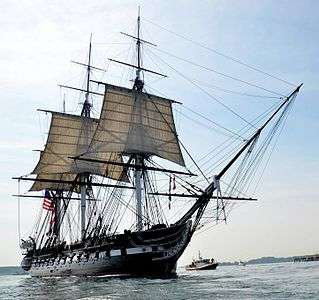 USS Constitution with sails on display in 2012, the oldest commissioned warship still afloat[83]
USS Constitution with sails on display in 2012, the oldest commissioned warship still afloat[83]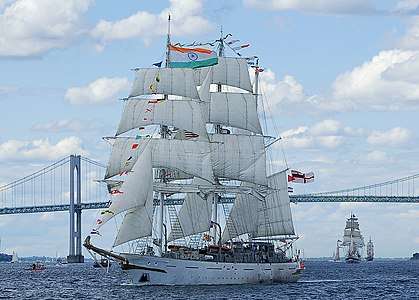 INS Tarangini, a three-masted barque in service with the Indian Navy
INS Tarangini, a three-masted barque in service with the Indian Navy.jpg) Maltese Falcon with all-rotating, stayless DynaRig
Maltese Falcon with all-rotating, stayless DynaRig
See also
- List of large sailing vessels
- Sailboat
- Sailing ship accidents
- Sailing ship effect—describing the transition between an old and new technology
- Sailing ship tactics
- Shipbuilding
References
- Quiller-Couch, Arthur Thomas (1895). The Story of the Sea. 1. Cassell and Company. p. 760.
- Parker, Dana T. Square Riggers in the United States and Canada, pp. 6–7, Transportation Trails, Polo, IL, 1994. ISBN 0-933449-19-4.
- "ship". Oxford English Dictionary (3rd ed.). Oxford University Press. September 2005. (Subscription or UK public library membership required.)
- Pacific American Steamship Association; Shipowners Association of the Pacific Coast (1920). "Safe Passage (Poem and photo of four masted John Ena in Canal)". Pacific Marine Review. San Francisco: J.S. Hines. 17 (October 1920). Retrieved 24 December 2014.
- Anderson, Romola; Anderson, R. C. (2003-09-01). A Short History of the Sailing Ship. Courier Corporation. ISBN 9780486429885.
- Merson, John (1990). The Genius That Was China: East and West in the Making of the Modern World. Woodstock, NY: The Overlook Press. ISBN 978-0-87951-397-9.
- Magnússon, Magnús (2016-10-06). The Vikings. Stroud [England]. p. 90. ISBN 978-0750980777. OCLC 972948057.
- Friedman, John Block; Figg, Kristen Mossler (2017-07-05). Routledge Revivals: Trade, Travel and Exploration in the Middle Ages (2000): An Encyclopedia. Taylor & Francis. p. 322. ISBN 9781351661324.
- Norman, Vesey (2010). The Medieval Soldier. Pen and Sword. ISBN 9781783031368.
- Meacham, Steve (11 December 2008). "Austronesians were first to sail the seas". The Sydney Morning Herald. Retrieved 28 April 2019.
- Doran, Edwin, Jr. (1974). "Outrigger Ages". The Journal of the Polynesian Society. 83 (2): 130–140.
- Mahdi, Waruno (1999). "The Dispersal of Austronesian boat forms in the Indian Ocean". In Blench, Roger; Spriggs, Matthew (eds.). Archaeology and Language III: Artefacts languages, and texts. One World Archaeology. 34. Routledge. pp. 144–179. ISBN 978-0415100540.
- Bellina, Bérénice (2014). "Southeast Asia and the Early Maritime Silk Road". In Guy, John (ed.). Lost Kingdoms of Early Southeast Asia: Hindu-Buddhist Sculpture 5th to 8th century. Yale University Press. pp. 22–25. ISBN 9781588395245.
- Manguin, Pierre-Yves (2016). "Austronesian Shipping in the Indian Ocean: From Outrigger Boats to Trading Ships". In Campbell, Gwyn (ed.). Early Exchange between Africa and the Wider Indian Ocean World. Palgrave Macmillan. pp. 51–76. ISBN 9783319338224.
- Doran, Edwin B. (1981). Wangka: Austronesian Canoe Origins. Texas A&M University Press. ISBN 9780890961070.
- Shaffer, Lynda Norene (1996). Maritime Southeast Asia to 1500. M.E. Sharpe. Quoting Johnstone 1980: 191–192
- Kang, Heejung (2015). "Kunlun and Kunlun Slaves as Buddhists in the Eyes of the Tang Chinese" (PDF). Kemanusiaan. 22 (1): 27–52.
- Grice, Elizabeth (17 March 2004). "A strange kind of dream come true". The Telegraph. Retrieved 3 November 2015.
- Haddon, A.C. (1920). The Outriggers of Indonesian Canoes. London, Royal Anthropological Institute of Great Britain and Ireland.
- Paine, Lincoln (2013). The Sea and Civilization: A Maritime History of the World. New York: Random House, LLC.
- Worcester, G. R. G. (1971). The Junks and Sampans of the Yangtze. Naval Institute Press. ISBN 0870213350.
- Hall, Kenneth R. (2010-12-28). A History of Early Southeast Asia: Maritime Trade and Societal Development, 100–1500. Rowman & Littlefield Publishers. p. 216. ISBN 9780742567627.
- Worcester, G. R. G. (1971). The Junks and Sampans of the Yangtze. Naval Institute Press. ISBN 0870213350.
- Nugroho, Irawan Djoko (2011). Majapahit Peradaban Maritim. Jakarta: Suluh Nuswantara Bakti. ISBN 978-602-9346-00-8.
- Wade, Geoff (2005). "The Zheng He Voyages: A Reassessment". Journal of the Malaysian Branch of the Royal Asiatic Society. 78 (1 (288)): 37–58. JSTOR 41493537.
- Gao, Sally. "A Brief History Of The Chinese Junk". Culture Trip. Retrieved 2019-06-02.
- Church, Sally K. (2005). "Zheng He: an investigation into the plausibility of 450-ft treasure ships". Monumenta Serica. 53: 1–43. doi:10.1179/mon.2005.53.1.001. JSTOR 40727457.
- Bulliet, Richard W.; Crossley, Pamela Kyle; Headrick, Daniel R.; Hirsch, Steven; Johnson, Lyman (2008). The Earth and Its Peoples: A Global History, Brief Edition, Volume I: To 1550: A Global History. Cengage Learning. pp. 352–3. ISBN 9780618992386.
- Konstam, A. (2002). The History of Shipwrecks. New York: Lyons Press. pp. 77–79. ISBN 1-58574-620-7.
- Block, Leo (2003). To Harness the Wind: A Short History of the Development of Sails. Naval Institute Press. ISBN 9781557502094.
- Diffie, Bailey W.; Winius, George D. (1977). Foundations of the Portuguese Empire, 1415–1850. Europe and the World in the Age of Expansion. 1. p. 177. ISBN 978-0-8166-0850-8.
- Murphy, Patrick J.; Coye, Ray W. (2013). Mutiny and Its Bounty: Leadership Lessons from the Age of Discovery. Yale University Press. ISBN 978-0-300-17028-3. Retrieved 2019-06-23.
- Bergreen, Laurence (2003). Over the edge of the world : Magellan's terrifying circumnavigation of the globe (1st ed.). New York: Morrow. ISBN 0066211735. OCLC 52047431.
- Kingston, William H. G. (2014-12-29). How Britannia came to Rule the Waves. BoD – Books on Demand. pp. 123–82. ISBN 9783845711935.
- Lavery, Brian (2012). Nelson's Navy: The Ships, Men and Organisation 1793–1815. Conway. ISBN 9781844861750.
- Gould, Richard A. (2011-04-29). Archaeology and the Social History of Ships. Cambridge University Press. p. 216. ISBN 9781139498166.
- Winfield, Rif; Roberts, Stephen S. (2017). French Warships in the Age of Sail 1626–1786. Pen & Sword Books Limited. ISBN 9781473893535.
- Villiers, Alan (1973). Men, ships, and the sea. National Geographic Society (U.S.) (New ed.). Washington ]: National Geographic Society. ISBN 0870440187. OCLC 533537.
- Baker, Kevin (2016). America the Ingenious: How a Nation of Dreamers, Immigrants, and Tinkerers Changed the World. Artisan Books. pp. 13–5. ISBN 9781579657291.
- McKee, A. in Bass (ed.) 1972, p.235
- Telegdi, J.; Trif, L.; Romanski, L. (2016). Montemor, Maria Fatima (ed.). Smart anti-biofouling composite coatings for naval applications. Smart composite coatings and membranes : transport, structural, environmental and energy applications. Cambridge, UK: Elsevier. pp. 130–1. ISBN 9781782422952. OCLC 928714218.
- Hay (May 15, 1863). On copper and other sheathing. The Engineer. London: Office for Publication and Advertisements. p. 276.
- Mccarthy, Michael (2005). Ships' Fastenings: From Sewn Boat to Steamship. Texas A&M University Press. p. 131. ISBN 9781603446211.
- Knight, R. J. B. "The introduction of copper sheathing into the Royal Navy, 1779–1786" (PDF). rogerknight.org. Retrieved 28 December 2017.
- Schäuffelen, Otmar (2005). Chapman Great Sailing Ships of the World. Hearst Books. ISBN 9781588163844.
- Randier, Jean (1968). Men and Ships Around Cape Horn, 1616–1939. Barker. p. 338.
- Cumming, Bill (2009). Gone – a chronicle of the seafarers & fabulous clipper ships of R & J Craig of Glasgow : Craig's "Counties". Glasgow: Brown, Son & Ferguson. ISBN 9781849270137. OCLC 491200437.
- Sutherland, Jonathan; Canwell, Diane (2007-07-07). Container Ships and Oil Tankers. Gareth Stevens. ISBN 9780836883770.
- Schäuffelen, Otmar (2005). Chapman Great Sailing Ships of the World. Hearst Books. ISBN 9781588163844.
- Staff (April 13, 2009). "Sailing at the touch of a button". Low-Tech Magazine. Retrieved 2019-06-20.
- Chatterton, Edward Keble (1915). Sailing Ships and Their Story :the Story of Their Development from the Earliest Times to the Present Day. Lippincott. pp. 298.
- "Black Pearl". www.boatinternational.com. Boat International Media Ltd. Retrieved 11 October 2018.
- Staff (2012). "Designing and Building a Wooden Ship". Penobscot Marine Museum. Retrieved 2019-06-22.
- Clark, Arthur Hamilton (1912). The Clipper Ship Era: An Epitome of Famous American and British Clipper Ships, Their Owners, Builders, Commanders, and Crews, 1843–1869. G.P. Putnam's Sons.
- Biddlecombe, George (1990). The Art of Rigging: Containing an Explanation of Terms and Phrases and the Progressive Method of Rigging Expressly Adapted for Sailing Ships. Dover Maritime Series. Courier Corporation. p. 13. ISBN 9780486263434.
- Keegan, John (1989). The Price of Admiralty. New York: Viking. pp. 278. ISBN 0-670-81416-4.
- Fincham, John (1843). A Treatise on Masting Ships and Mast Making: Explaining Their Principles and Practical Operations, the Mode of Forming and Combining Made-masts, Etc. London: Whittaker. pp. 216–30.
- Harland, John. Seamanship in the Age of Sail, pp. 15, 19–22, 36–37, Naval Institute Press, Annapolis, Maryland, 1992. ISBN 0-87021-955-3.
- Clerc-Rampal, G. (1913) Mer : la Mer Dans la Nature, la Mer et l'Homme, Paris: Librairie Larousse, p. 213
- Folkard, Henry Coleman (2012). Sailing Boats from Around the World: The Classic 1906 Treatise. Dover Maritime. Courier Corporation. p. 576. ISBN 9780486311340.
- zu Mondfeld, Wolfram (2005). Historic Ship Models. Sterling Publishing Company, Inc. p. 352. ISBN 9781402721861.
- Howard, Jim; Doane, Charles J. (2000). Handbook of Offshore Cruising: The Dream and Reality of Modern Ocean Cruising. Sheridan House, Inc. p. 468. ISBN 9781574090932.
- Editors. "Seamanship – Oxford Reference". www.oxfordreference.com. p. Seamanship. doi:10.1093/oi/authority.20110803100450237 (inactive 2020-01-25). Retrieved 2019-06-24.CS1 maint: extra text: authors list (link)
- Tony Gray. "Workshop Hints: Ship's Bells". The British Horological Institute. Archived from the original on 9 November 2012. Retrieved 12 June 2011.
- Dana, Richard Henry (1895). Two Years Before the Mast: A Personal Narrative. Houghton, Mifflin. pp. 11–13.
- Armstrong, John (2017-12-01). The Vital Spark: The British Coastal Trade, 1700–1930. Oxford University Press. ISBN 9781786948960.
- Melville, Herman (1850). White-jacket; Or, The World in the Man-of-war. Harper. pp. 14–8.
- Lavery, Brian (1983). The ship of the line. London: Conway Maritime Press. ISBN 0851772528. OCLC 10361880.
- Queeney, Tim (April 25, 2014). "Square sail handling – Ocean Navigator – May/June 2014". www.oceannavigator.com. Retrieved 2019-06-23.
- Mayne, Richard (2000). The Language of Sailing. New York: Routledge. pp. reef. ISBN 9781135965655.
- Editor (January 1, 2003). "Tall ship sail handling – Ocean Navigator – January/February 2003". www.oceannavigator.com. Retrieved 2019-06-23.CS1 maint: extra text: authors list (link)
- Royce, Patrick M. (1997). Royce's Sailing Illustrated. ProStar Publications. ISBN 9780911284072.
- Findlay, Gordon D. (2005). My Hand on the Tiller. AuthorHouse. p. 138. ISBN 9781456793500.
- Goodwin, Peter (2018-01-25). HMS Victory Pocket Manual 1805: Admiral Nelson's Flagship At Trafalgar. Bloomsbury Publishing. ISBN 9781472834072.
- Jobson, Gary (2008). Sailing Fundamentals (Revised ed.). Simon and Schuster. p. 224. ISBN 978-1-4391-3678-2.
- Campbell, I.C. (1995), "The Lateen Sail in World History" (PDF), Journal of World History, 6 (1), pp. 1–23, archived from the original (PDF) on 2016-08-04, retrieved 2017-06-16
- Skeat, Walter W. (2013). An Etymological Dictionary of the English Language. Dover language guides (Reprint ed.). Courier Corporation. p. 351. ISBN 978-0-486-31765-6.
- Johnston, Andrew K.; Connor, Roger D.; Stephens, Carlene E.; Ceruzzi, Paul E. (2015-06-02). Time and Navigation: The Untold Story of Getting from Here to There. Smithsonian Institution. ISBN 9781588344922.
- Encyclopædia Britannica (1911). "Sextant". In Chisholm, Hugh (ed.). Encyclopædia Britannica. 24 (11th ed.). New York : Encyclopaedia Britannica. pp. 749–751. Retrieved 2015-01-25.
- Turpin, Edward A.; MacEwen, William A.; Hayler, William B. (1965). Merchant Marine officers' handbook. Cambridge, Md.: Cornell Maritime Press. ISBN 087033056X. OCLC 228950964.
- Whidden, John D. (1912). Ocean Life in the Old Sailing Ship Days: From Forecastle to Quarter-deck. Little, Brown, & Co.
- "Cutty Sark". Royal Museums Greenwich Website. Retrieved July 29, 2014.
- Parker, Dana T. Square Riggers in the United States and Canada, p. 12, Transportation Trails, Polo, IL, 1994. ISBN 0-933449-19-4.
External links
| Look up sailing ship in Wiktionary, the free dictionary. |
![]()